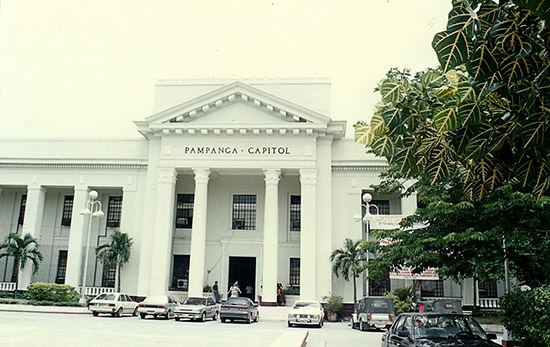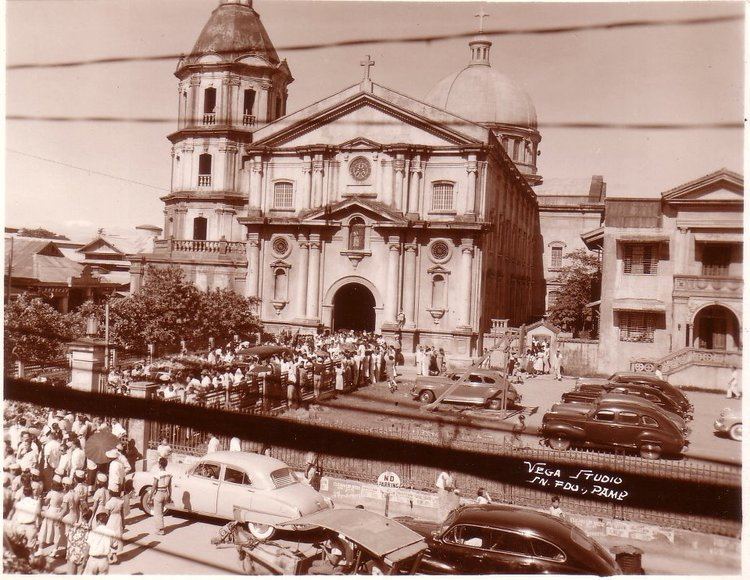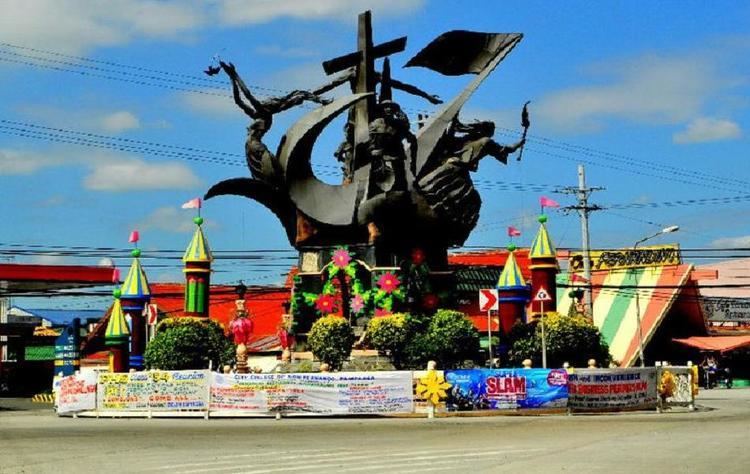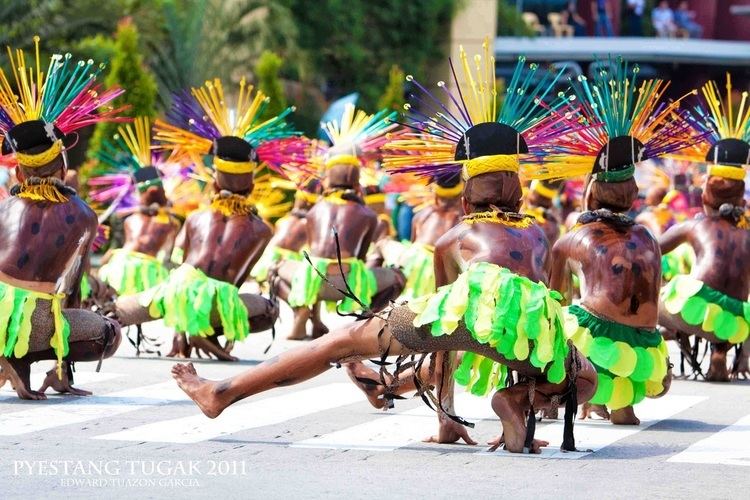Country Region Mayor Edwin Santiago (Liberal) | Population 269,365 (2007) Area 67.74 km2 Founded August 16, 1754 | |
 | ||
Languages spoken Similar Cebu City , Baguio , Central Luzon | ||
Map of San Fernando, Pampanga
San Fernando, officially and often referred to as the City of San Fernando and shortened or abbreviated as CSFP or SFP (Kapampangan: Lakanbalen ning San Fernando; Filipino: Lungsod ng San Fernando) is a first-class Component city in the Philippine Province of Pampanga, of which it is the provincial capital. The regional center of Central Luzon (Region III), it has a population of 306,659 people according to the 2015 census. It is located 66 kilometres (41 mi) north of Manila, 73 kilometres (45 mi) east of Subic in Zambales, and 17 kilometres (11 mi) south of Clark Air Base in Angeles City.
Contents
- Map of San Fernando Pampanga
- Top tourist destinations in san fernando pampanga wmv
- Beverly place residential estates san fernando pampanga
- Barangays
- History
- Cityhood
- Religions
- Economy
- Manufacturing
- Mayors
- Vocational Technical Schools
- Places of interest
- San Fernando Heritage District
- Notable Fernandinos
- Sister Cities
- References

The city is named after King Ferdinand VI of Spain and placed under the patronage of Saint Ferdinand III of Castile and León, whose feast is celebrated every 30 May. Popularly known as the "Christmas Capital of the Philippines", the city holds the annual Giant Lantern Festival every December where large parol are displayed in competition.

Top tourist destinations in san fernando pampanga wmv
Beverly place residential estates san fernando pampanga
Barangays

The City of San Fernando is politically subdivided into 35 Barangays.
History
The town of San Fernando was founded in 1754 from the towns of Bacolor and Mexico. The first church was built in 1755 with wooden walls and nipa roofing. The municipal tribunal was erected later in the year in front of the town plaza using durable materials and thatched nipa roofing. Don Vidal de Arrozal served as its first gobernadorcillo that year.
In 1796, after serving as gobernadorcillo the previous year, Don Ángel Pantaleon de Miranda retired to Barrio Saguin, from where he started setting up his hacienda in Barrio Culiat. The barrio was separated from San Fernando on the December 8, 1829 as the new town of Angeles, with the Los Santos Ángeles Custodios as titular patrons.
An expediente requesting the transfer of the provincial capital of Pampanga to San Fernando was signed on the August 6, 1852. Real Cedula 745, approving the transfer of the provincial capital of Pampanga from Bacolor to San Fernando, was signed on September 11, 1881. This transfer did not, in the event, materialize.
In 1878, actions were made to create the town of Calulut. This new town would be composed of Calulut and the neighboring barrios of Bulaun, Malpitic, Sindalan, La Paz, Lara, Saguin, Telabastagan, Balete, Malinao, Pulung Bulu, Panipuan, Macabacle and the caserio of Pau in San Fernando, and Panipuan, Acle, Suclaban and the sitio of Gandus in Mexico. This plan did not materialize, owing to strong opposition from the parish priest of San Fernando.
Governor-General Eulogio Despujol and Manila Archbishop Bernardino Nozaleda inaugurated the San Fernando railroad station, together with the Bagbag-Mabalacat stretch of the Manila-Dagupan Railroad, on February 2, 1892. The station was second only to Manila in revenues that year, and was thus the most important provincial station of the Manila-Dagupan Railroad. On June 27 of the same year, Dr. José P. Rizal made a stopover in the town as part of his mission to recruit members to the La Liga Filipina.
On September 1, 1896 the town was declared to be in a state of war despite its peaceful situation. Brigadier General Diego de los Rios arrived on December 2 to calm the revolution that started in Manila on August 30. General Ruiz Serralde took over Rios's post on June 26, 1897 to maintain the peace in San Fernando. The revolution was not yet at its height with occasional exchanges of fire in some places in Pampanga.
On June 26, 1898, representatives from all Pampanga towns, except Macabebe, gathered in San Fernando to swear allegiance to Gen. Maximino Hizon, who was the provincial military governor and representative of the revolutionary president, Emilio Aguinaldo. On October 9, Aguinaldo and his cabinet visited the town, and were welcomed with so much applause and enthusiastic cheering from the public. He proceeded to the convento which was served as the military headquarters at that time.
On May 4, 1899, Philippine revolutionary troops led by General Antonio Luna burned the casa municipal, the town church and several houses to render them useless to the approaching American forces. On June 16, due to the strategic location of the town, Aguinaldo himself led Filipino forces in the Battle for San Fernando. The plan to retake the town proved unsuccessful. Calulut fell to the Americans on August 9.
On August 15, 1904, the Pampanga provincial government was finally transferred to San Fernando from Bacolor, by virtue of Act No. 1204 signed on July 22, 1904. This was during the term of Governor Macario Arnedo and Municipal President Juan Sengson. The town of Minalin became part of San Fernando that same year. It would regain its political independence in 1909.
On January 2, 1905, the town of Santo Tomas was consolidated with San Fernando by virtue of Act 1208.
On August 12, 1904, U.S. Secretary of War William H. Taft visited the town to get first-hand information and gather ideas for the governance of Pampanga. Owing to the short notice, a bamboo pavilion was hastily constructed for his visit, where he was welcomed with a banquet for 200 people. Taft would later be elected President of the United States.
In 1921, the Pampanga Sugar Development Company (PASUDECO) sugar central began its operations. The company was formed in 1918 by large-scale planters such as José de León, Augusto Gonzales, Francisco Tongio Liongson, Tomás Lazatin, Tomás Consunji, Francisco Hizon, José Henson, and Manuel Urquico in the San Fernando residence of Governor Honorio Ventura as part of a plan to construct a locally financed central.
In 1932, the Socialist Party of the Philippines was founded by Pedro Abad Santos. Two years later, he created and headed the Aguman Ding Madlang Talapagobra (AMT). The Abad Santos compound in Barangay San Jose became the focal point of the peasant movement.
On February 14, 1939, Philippine president Manuel L. Quezon proclaimed his social justice program before a gathering of farmers in front of the Municipal Government building.
In 1941, forces of the Japanese Imperial Army occupied the town and placed the municipal government under its supervision. The following year, thousands of Filipino and American POWs walked from Bataan to the San Fernando Train Station in what will be known as the Bataan Death March.
In 1952, the town of Santo Tomas was separated from San Fernando.
In 1986, Paterno Guevarra was sworn in as officer-in-charge of the town after the successful People Power Revolution that toppled the Marcos dictatorship that same year. He was later elected municipal mayor.
In 1990, Philippine president Corazon C. Aquino inaugurated the Paskuhan Village, the first Christmas village in Asia and the third of its kind in the world. The following year, Mount Pinatubo erupted after over 600 years of dormancy hurling a layer of ash and volcanic debris on the town.
On October 1, 1995, Typhoon Sibyl (Mameng) struck the town. It unleashed floodwaters and mudflows from Mount Pinatubo into the town. The Barangays of Sto. Nino, San Juan, San Pedro Cutud and Magliman were severely damaged by lahar. The citizens of San Fernando rallied to save the town by raising funds to build the St. Ferdinand People's Dike. The Pampanga Megadike was constructed the following year, thus preventing further damage to the town.
Cityhood
On January 6, 1997, Mayor Rey B. Aquino and Senator Gloria Macapagal-Arroyo launched the campaign for cityhood. On April 27 of that same year, Rep. Oscar Rodriguez filed House Bill No. 9267 creating the City of San Fernando.
In 2000, House Speaker Arnulfo Fuentebella and Senate President Aquilino Q. Pimintel signed the approved city charter of San Fernando on December 4 and 13 respectively.
The town officially became a component city on February 4, 2001 following the ratification of Republic Act 8990 in a plebiscite from the previous day, making it the 99th city in the Philippines. Dr. Rey B. Aquino was the city's first mayor.
Religions
The Roman Catholicism is the majority religion in the city; 80% of the population profess it. The city is under the Roman Catholic Archdiocese of San Fernando headed by Florentino Lavarias. Other religion includes Protestantism and Independent Christianity. Islam is also evident in the city. The seat of the Archdiocese of San Fernando is located in the city, the Metropolitan Cathedral of San Fernando.
Economy
Strategically located at the heart of the province, the City of San Fernando is home to two public markets, thirty-nine banks, forty-eight lending institutions (investors), thirty-eight pawnshops, seventeen gasoline stations, three movie houses, thirty-nine public and private schools, seven hospitals, thirteen dental offices, nine hotels, twenty-eight drug stores, seven disco clubs, six foreign exchange firms, fifteen garment factories, twenty-four groceries, seven supermarkets, forty-two insurance companies, sixteen security agencies and seventy restaurants and fast food chains such as Jollibee, McDonald's, Mr. Donut, Greenwich, Shakey's, and Chowking. In addition to being the Provincial Capital of Pampanga, almost all Philippine banking institutions, military and governmental agencies have regional offices in the City of San Fernando. SM City Pampanga is a large shopping mall owned by Henry Sy, Sr. and his company, SM Prime Holdings. It is the very first SM Supermall in Central Luzon. Robinsons Starmills Pampanga or Robinsons Starmills is a shopping mall owned and operated by John Gokongwei and his company, Robinsons Malls, the second-largest mall operator in the Philippines. This is the very first Robinsons Mall in the Central Luzon and in the Pampanga Province, rivaling adjacent SM City Pampanga. The mall is located at Jose Abad Santos Avenue, Barangay San Jose, San Fernando, Pampanga and Barangay Lagundi in the neighboring town of Mexico, Pampanga with a total floor area of 62,000 square meters (667,120 square feet).
Manufacturing
San Fernando serves as one of the agricultural processing center of Central Luzon. It is a major rice-producing region and an important sugar-producing area. The Pampanga Sugar Development Company (PASUDECO) was once the largest private employer in Pampanga. It is a major sugar-processing plant in the region. Other manufacturing companies with offices in the city include Universal Robina Corporation, Zuellig Pharma Corporation, Nestlé Philippines, Petrophil, Mondragon Industries, Asia Brewery, and Del Monte Corporation. Major bottling companies such as the San Miguel Corporation Complex, Coca-Cola, Pepsi Cola, Cosmos and Metrobottling, Pampanga's Best Inc. are located within the city.
Every year during the Christmas season, the city becomes the hub of a thriving industry centered on handcrafted lanterns called parols. What distinguish the San Fernando lantern from the ordinary parol are the intricate designs and the illusion of dancing lights, which focuses on the vibrant colors of the lantern. Also, every year around Christmas time, there is a town lantern festival. Different neighborhoods around San Fernando, come together for a friendly competition to see which neighborhoods lanterns are the best. The festival itself is held in the middle of December, rooted back to the city of Bacolor. The transfer from the city of Bacolor to the city of San Fernando in August 1904. In the dialect called Kapampangan, this event is called "Ligligan Parol". But, for many who have experienced this say that "Ligligan Parol" did not actually quite happen. Especially following up the immediate transfer of customs between the 2 cities in the year 1908. It went on to be a tradition that has evolved as the lantern gradually became larger and larger and more intricate each year. Years later, the lantern itself was a symbol for the resident contribution, benefiting their labor. The soul purpose of these lanterns symbolized the unity amongst different neighborhoods.
Mayors
This is the list of the mayors of City of San Fernando.
Vocational / Technical Schools
Places of interest
San Fernando Heritage District
The City of San Fernando Heritage District covers the historic core of San Fernando, including Barangay Santo Rosario and parts of Barangays San Jose (Panlumacan), Santa Teresita (Baritan), Lourdes (Teopaco), Del Pilar, Santa Lucia and Santo Niño. These important sites are broken down under Heritage Houses, Historic Government Buildings, Schools, and Hospitals, and Historic Industrial Structures and Sites
Churches and Other Religious Structures:
Heritage Houses:
Historic Government Buildings, Schools, and Hospitals:
Industrial Heritage Structures and Sites:
